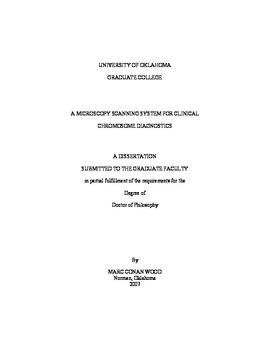| dc.contributor.advisor | Liu, Hong, | en_US |
| dc.contributor.author | Wood, Marc Conan. | en_US |
| dc.date.accessioned | 2013-08-16T12:20:54Z | |
| dc.date.available | 2013-08-16T12:20:54Z | |
| dc.date.issued | 2007 | en_US |
| dc.identifier.uri | https://hdl.handle.net/11244/1264 | |
| dc.description.abstract | During the course of this research, the following papers were authored or co-authored: (1) X. Wang, B. Zheng, M. Wood, S. Li, W. R. Chen, and H. Liu, "Development and Evaluation of Automated Systems for Detection and Classification of Banded Chromosome: Current Status and Future Perspectives", Journal of Physics D: Applied Physics, vol 38, 2005, pp 2536-2542. (2) X. Wang, S. Li, H. Liu, M. Wood, W. R. Chen, and B. Zheng, "Automated Identification of Analyzable Metaphase Chromosomes Depicted on Microscopic Digital Images", Journal of Biomedical Informatics, 2007. (Accepted for publication). | en_US |
| dc.description.abstract | An important part of the diagnosis and treatment of leukemia is the visual examination of the patient's chromosomes. Chomosomal changes serve as indicators of the nature and severity of the disease. Clinical genetics laboratories acquire images of metaphase chromosomes using a microscope and camera system, usually by manual search of the tissue slides. Manual techniques are labor intensive, slow and costly. A computer controlled scanning system can be an important tool for automating and expediting the chromosome analysis process. Commercial systems have been developed, but fall short of providing an automated (or even semi-automated) computer aided diagnosis technique. This dissertation describes the design and development of a prototype scanning system, and studies the impact of the scanning speed on the image quality, with an eye towards the development of a Computer Aided Diagnostic (CAD) system. The system consists of a laboratory grade microscope, a high-precision motorized stage, a video imaging system, and controlling software. An entire slide can be imaged and captured into a digital file for later review. Fast scan rates make a system more productive, which is essential for clinical practice, but motion blur can render the images unusable for post image processing and computer assisted diagnosis. Experimentally in this research, clinical chromosome images and resolution patterns were scanned under different objective lens magnifications ranges from 10X to 100X, at different scanning speed from 0mm/sec to 4mm/sec. These images were reviewed by observers. Significant motion blurs were observed at high magnification and scanning speed. The impact of scanning speed was also quantified by objective parameters such as modulation transfer functions (MTF). For example, with an objective lens power of 10X, the essential structure of a metaphase spread can still be visually detected with a scan speed of 4 mm/sec, whereas at that speed, the image under 60X and higher objective power is not recognized. Accordingly, an optimal design strategy for an efficient clinical system should balance optical magnification, scanning speed, as well as the frame rate of the camera. | en_US |
| dc.format.extent | x, 118 leaves : | en_US |
| dc.subject | Engineering, Biomedical. | en_US |
| dc.subject | Chromosomes Analysis. | en_US |
| dc.subject | Medical microscopy. | en_US |
| dc.subject | Engineering, Electronics and Electrical. | en_US |
| dc.title | A microscopy scanning system for clinical chromosome diagnostics. | en_US |
| dc.type | Thesis | en_US |
| dc.thesis.degree | Ph.D. | en_US |
| dc.thesis.degreeDiscipline | School of Electrical and Computer Engineering | en_US |
| dc.note | Adviser: Hong Liu. | en_US |
| dc.note | Source: Dissertation Abstracts International, Volume: 68-10, Section: B, page: 6876. | en_US |
| ou.identifier | (UMI)AAI3283865 | en_US |
| ou.group | College of Engineering::School of Electrical and Computer Engineering | |
